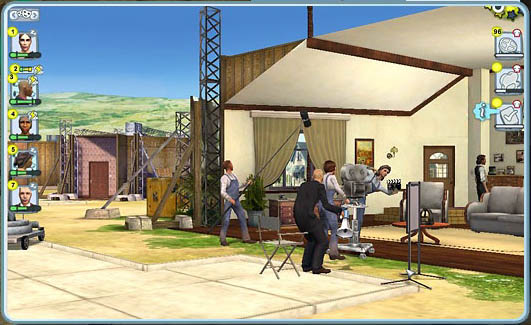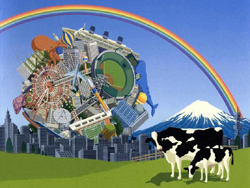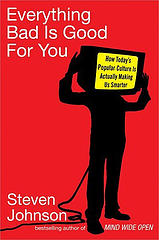
I’m pleased to report that the institute is gearing up for another book-blog experiment to run alongside Mitchell Stephens’ ongoing endeavor at Without Gods — this one a collaboration with McKenzie Wark, professor of cultural and media studies at the New School and author most recently of A Hacker Manifesto. Ken’s next book, Gamer Theory, is an examination of single-player video games that comes out of the analytic tradition of the Frankfurt School (among other influences). Unlike Mitch’s project (a history of atheism), Ken’s book is already written — or a draft of it anyway — so in putting together a public portal, we are faced with a very different set of challenges.
As with Hacker Manifesto, Ken has written Gamer Theory in numbered paragraphs, a modular structure that makes the text highly adaptable to different formats and distribution schemes — be it RSS syndication, ebook, or print copy. We thought the obvious thing to do, then, would be to release the book serially, chunk by chunk, and to gather commentary and feedback from readers as it progressed. The trouble is that if you do only this — that is, syndicate the book and gather feedback — you forfeit the possibility of a more free-flowing discussion, which could end up being just as valuable (or more) as the direct critique of the book. After all, the point of this experiment is to expose the book to the collective knowledge, experience and multiple viewpoints of the network. If new ideas are to be brought to light, then there ought to be ways for readers to contribute, not just in direct response to material the author has put forth, but in their own terms (this returns us to the tricky proprietary nature of blogs that Dan discussed on Monday).
So for the past couple of weeks, we’ve been hashing out a fairly ambitious design for a web site — a blog, but a little more complicated — that attempts to solve (or at least begin to solve) some of the problems outlined above. Our first aim was to infuse the single-author book/blog with the democratic, free-fire discussion of list servers — a feat, of course, that is far easier said than done. Another concern, simply from an interface standpoint, was to find ways of organizing the real estate of the screen that are more intuitive for reading.
Another thing we’ve lamented about blogs, and web sites in general, is their overwhelming verticality. Vertical scrolling fields — an artifact of supercomputer terminals and the long spools of code they spit out — are taken for granted as the standard way to read online. But nowhere was this ordained as the ideal interface — in fact it is designed more for machines than for humans, yet humans are the users on the front end. Text does admittedly flow down, but we read left to right, and its easier to move your eye across a text that is fixed than one that is constantly moving. A site we’ve often admired is The International Herald Tribune, which arranges its articles in elegant, fixed plates that flip horizontally from one to the next. With these things in mind, we set it as a challenge for ourselves to try for some kind of horizontally oriented design for Ken’s blog.
There’s been a fairly rigorous back and forth on email over the past two weeks in which we’ve wrestled with these questions, and in the interest of working in the open, we’ve posted the exchange below (most of it anyway) with the thought that it might actually shed some light on what happens — from design and conceptual standpoints — when you try to mash up two inherently different forms, the blog and the book. Jesse has been the main creative force behind the design, and he’s put together a lovely annotated page explaining the various mockups we’ve developed over the past week. If you read the emails (which are can be found directly below this paragraph) you will see that we are still very much in the midst of figuring this out. Feedback would be much appreciated. (See also GAM3R 7H30RY: part 2).


 People around me have much more sophisticated outfits than I do. So, I try out the free clothing features. I darken my pants to a deep blue and my shoes black. Then, my default shirt gets turned into a loose white t-shirt. Somehow I end up a bit like a GAP model crossed with Max Headroom. After making my first “friend,” another complete stranger comes up to me and just starts giving me clothes. Apparently, my clothes still need a little work. I try on the cowboy boots and faded jeans. Happy that I’ve moved beyond the standard issue clothes, I thank my benefactor and begin to make my way to the event.
People around me have much more sophisticated outfits than I do. So, I try out the free clothing features. I darken my pants to a deep blue and my shoes black. Then, my default shirt gets turned into a loose white t-shirt. Somehow I end up a bit like a GAP model crossed with Max Headroom. After making my first “friend,” another complete stranger comes up to me and just starts giving me clothes. Apparently, my clothes still need a little work. I try on the cowboy boots and faded jeans. Happy that I’ve moved beyond the standard issue clothes, I thank my benefactor and begin to make my way to the event. The interview is about to begin, as an avatar with large red wings walks by me. I say out loud, “I know she was going to sit in front of me.” Adding, “Just kidding,” in case I might be offending someone, who knows who this person could be. Fortunately, she found a seat outside my sight line without incident, and the introductory remarks began.
The interview is about to begin, as an avatar with large red wings walks by me. I say out loud, “I know she was going to sit in front of me.” Adding, “Just kidding,” in case I might be offending someone, who knows who this person could be. Fortunately, she found a seat outside my sight line without incident, and the introductory remarks began.





 the following is slightly edited analysis of the game by rylish moeller, an english prof who is very active on the
the following is slightly edited analysis of the game by rylish moeller, an english prof who is very active on the 